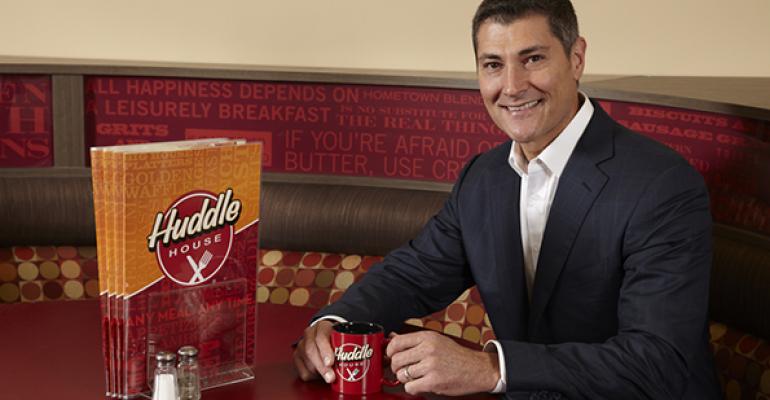Huddle House has been in turnaround mode since Sentinel Capital Partners acquired the brand in April 2012. The family-dining chain has a new executive suite led by chief executive Michael Abt, who joined the company in October 2012.
“It’s been a very busy two years,” said Abt, who joined Huddle House from Arby’s, where he most recently was senior vice president of operations.
The chain has seen 11 months of same-store sales growth, most recently of 3.7 percent for the month of Novemeber 2014, and an increase in unit openings from eight last fiscal year to a projected 16 in the year ending in April 2015. Huddle House’s systemwide sales rose 1.6 percent during the year to April 30, 2014, according to NRN’s Top 200 data. Sales declined on average 2.8 percent among family-dining chains in NRN’s Second 100 census.
Abt discussed Huddle House’s turnaround and his plans for the 376-unit chain, which is celebrating its 50th anniversary, with Nation’s Restaurant News.
How did you return Huddle House to positive performance?
It was blocking and tackling, Restaurant Operations 101. One of the things we did from an operations standpoint is develop a four-walls operations plan, and from there we developed new training materials: an “eagles playbook.” We want to hire eagles and not turkeys, and the playbook helps show [management] what to look for when hiring and techniques to train, develop, encourage and motivate them.
As a result, we’ve increased our customer service index — covering nine key attributes, including temperature and quality of food and friendliness of staff — from 74.5 to 80.1 over the past year.
We’ve really been focusing on supporting our franchise partners. We have signs in our office saying, “What will I do today to serve the needs of our franchise partners?”
How is Huddle House’s remodeling program going?
We have a prototype restaurant that we developed about two years ago — I really can’t take a lot of credit for it. For the 45 remodels that have been completed since June of 2013, were realizing a 16.1-percent same-store-sales increase. Last year we also developed a remodel incentive program that gives $25,000 to any franchise partner who remodels.
How much does a remodel cost?
Generally $100,000 to $120,000. The benefits of course are greater profitability for the franchise partners who can then afford to put more money into the business, and potentially open new restaurants.
Describe the new design.
It’s sort of contemporary-looking exterior, with a tower and a new font and logo. We’ve switched colors from white and brick to a tan/lighter brown combination with decorative awnings. Inside are pendant lights; comfortable, colorful seatbacks; and quilted stainless steel along the wall that really gives it that diner feel. We added a wall covering with the names of Huddle House products, like the Chop House Burger, Philly Cheesesteak Omelets and the Double Huddle Burger.
We’ve also increased grill capacity and warming drawers that helps us during our busiest times, which are Saturday and Sunday breakfast.
How has marketing changed?
We brought on a CMO from TGI Fridays, Alison Delaney, who spent a lot of time in menu and product development there. At Huddle House, she launched Big Bold Burgers a year ago and increased burger sales by 20 percent. In July, we launched Hot Tots [tater tots added to omelets] as a three-month LTO, and they accounted for about 8 percent of sales. We’re currently working on a maple bacon platform that we’ll start testing in mid-December, and a “waffle wich” concept of breakfast and lunch sandwiches that we’ll test after that.
Tell me more about the maple bacon platform.
We’ve managed to get bacon particulates [suspended] in the maple syrup so they don’t fall to the bottom, so when you apply the syrup to waffles, French toast or pancakes you get pieces of chopped bacon in it. Now we’re focusing on building the product pipeline and making sure that it’s solid.
We’ve also optimized our print and saw a 35-percent increase in coupons that have been redeemed.
How did you do that?
We tested many variations of print advertising and found that the key to redemption was total number of coupons per piece. So we went from 12 coupons per insert to 22. We also closely monitored what coupons were redeemed. For example, we offered coupons for country fried steak [normally $7.99] at $2 off or at $5.99, and found that $5.99 was much more attractive than the $2-off offer. It was variations of coupons like that that led us to the optimization that we have now.
What are you planning next?
Our next key focus will be on developing a loyalty/social/digital platform. We don’t have the market penetration to be on TV, but we think social media works well when you communicate with existing customers. We have very loyal customers: 60 percent of our revenue is generated by 35 percent of our customers, so it’s important for us to understand how we can build programs to incent our customers to visit more frequently.
This story has been revised to reflect the following correction:
Correction: Dec. 2, 2014 An earlier version of this story misstated Huddle House's November 2014 same-store sales. The chain's same-store sales rose 3.7 percent during the month.
Contact Bret Thorn at [email protected].
Follow him on Twitter: @foodwriterdiary





